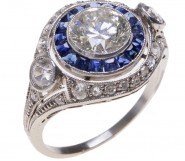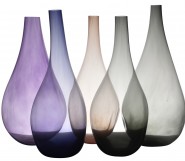Lot #16 - Rover Thomas (Joolama)
-
Auction House:Mossgreen
-
Sale Name:Important Art
-
Sale Date:20 Nov 2017 ~ 6.30pm
-
Lot #:16
-
Lot Description:Rover Thomas (Joolama)
(circa 1926-1998)
Tumbi (Owl), 1989
natural earth pigments and binder on canvas
120 x 64 cm
inscribed, titled and dated verso on stretcher: ‘Rover Thomas/ Dunbi [sic] and dated 1989’ -
Provenance:Acquired on behalf of Mr. Stephen Muecke directly from the artist by Mr. Krim Benterrak at Warmun (Turkey Creek) in August/September 1989; John Cruthers, Art Consultant; Martin Copley AM, Perth
-
Exhibited:The Presence of Greatness, Early Wanjina Paintings & Indigenous Art of Western Australia, Tim Klingender Fine Art, Sydney Contemporary 13 art fair, 19-22 September 2013, Carriageworks, cat. no. 10
-
References:Kim Akerman, The Presence of Greatness, Early Wanjina Paintings & Indigenous Art of Western Australia, Tim Klingender Fine Art, Sydney Contemporary 13 art fair, 2013, pp. 24-5 (illustrated)
-
Notes:There are eleven species of owl in Australia and about half of them are found in Northern Australia. Rover Thomas painted many of those species including; The Masked Owl (Tyto novae hollandiae kimberlii), the Owlet Nightjar (Aegtheles cristatus), the Spotted Nightjar (Eurostopodus argus) and the Barking Owl, as well as a related nightbird, the Tawny Frogmouth (Podgargus strigoides). The Barking Owl (Ninox connivens) with its prominent spectacle like eyes is often mistaken for a Southern Boobook (Ninox novaeseelandie). The subsepecies Rover Thomas painted was the N. connivens peninsularis found in Northern Australia. It is best known for its distinctive bark a double-note wook wook, which sounds like a dog but it also makes a second more disturbing sound, a wavering human-like scream which has given rise to one of its other names, The Screaming Woman. Early settlers often mistook the owl’s cries for a woman coming to grief in the bush. In his depiction of owls Rover Thomas developed his own range of conventions to distinguish the species he was painting and while who might revisit a subject he rarely repeated himself. Rover Thomas has shown the Barking Owl, as three toed, its distinctive bright yellow eyes are depicted as double round circles with a dark dot pupil, in dotted outline it has a wide full lozenge mouth and a long straight vertical nose/beak, its wings fly out like a dressing gown and in the distinctive cleft made by the crossing over of the tail feathers, the artist has simultaneously shown the bird from the rear. The expressive face and angles of inclination to the body animate the figure with a benign almost human presence. Rover Thomas does not depicts owls in flight but rather still and watchful from a canonical perspective to clearly show their distinguishing features. Many of his owls float freely in an imperial space, while others hide away, secreted in hollows and crevices. This owl is framed or enclosed by what could be a tree hollow, which visually functions as a plinth for a sculpture, or an enclosure or niche to hold a revered figure. This work, ‘Tumbi (Owl)’, 1989 is most comparable to the Holmes a Court Collection work, ‘Grugrugi: Owl’, 1989 a double owl in the playing card format top to tail which was painted for Mary Macha. Owls in paintings by Rover Thomas are called variously Tumbi, Dimbi/ Dunby / Dunbi / Dumbun or Grugrugi/ Grougrugi and Goolgool and the name relates less to the species and more to the associated story. In this case the story of Tumbi, Rover Thomas has painted the baby owl who belonged to the Wanjina and was tormented by two boys. To punish the cruel and thoughtless humans, the Wanjina sent a down a great flood1. While undoubtedly a popular and appealing subject, Rover Thomas only created some fifteen paintings of owls and as Kim Akerman noted this is one of the “exceptional examples”2. Only a few were painted for Waringarri Arts in Kununurrra including one notable work, ‘The Story of Owl’, 1988, which went into Art Gallery of SA; a number were painted for Mary Macha, while others like this one were painted for a particular person as a unique commission, usually someone who had worked at Warmun. Almost all of Rover Thomas’ owls were painted in the early stage of his career around 1988/89 and before the Venice Biennale in 1990, including his best known ‘Goolgool the Owl with four young’, 1988 in the AGWA Collection and actually not owls but tawny frogmouths. In his latter career Rover Thomas rarely returned to this subject. Dr Suzanne Spunner 1 Kim Akerman, Wanjina: ‘Notes on Some Iconic Ancestral Beings of the Northern Kimberley’, Hesperion Press, WA, 2016, see pp116-134; 2 Kim Akerman, ‘The Presence of Greatness, Early Wanjina Paintings & Indigenous Art of Western Australia’, Tim Klingender Fine Art, Sydney Contemporary 13 Art Fair, 2013 pp24-5 (illustrated)
-
Estimate:A$150,000 - 200,000
-
Realised Price:
-
Category:Art
This Sale has been held and this item is no longer available. Details are provided for information purposes only.










